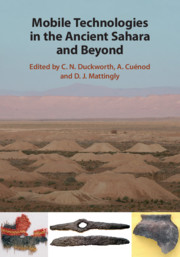Book contents
- Mobile Technologies in the Ancient Sahara and Beyond
- The Trans-Saharan Archaeology Series
- Mobile Technologies in the Ancient Sahara and Beyond
- Copyright page
- Contents
- Figures
- Tables
- Contributors
- Preface
- Part I Introduction
- Part II Technological Mobility and Transfers
- 2 Technological Innovations Transfer through the Hyper-Arid Belt
- 3 The Diffusion of Irrigation Technologies in the Sahara in Antiquity
- 4 Crafts in Roman North Africa
- 5 Movement and Management of Animals in the North and West of Africa from 1000 BC to AD 1000
- 6 The Early History of Weaving in West Africa
- Part III Metallurgy
- Part IV Glass Technology
- Part V Handmade Pottery
- Part VI Conclusion
- Index
- References
3 - The Diffusion of Irrigation Technologies in the Sahara in Antiquity
Settlement, Trade and Migration
from Part II - Technological Mobility and Transfers
Published online by Cambridge University Press: 18 September 2020
- Mobile Technologies in the Ancient Sahara and Beyond
- The Trans-Saharan Archaeology Series
- Mobile Technologies in the Ancient Sahara and Beyond
- Copyright page
- Contents
- Figures
- Tables
- Contributors
- Preface
- Part I Introduction
- Part II Technological Mobility and Transfers
- 2 Technological Innovations Transfer through the Hyper-Arid Belt
- 3 The Diffusion of Irrigation Technologies in the Sahara in Antiquity
- 4 Crafts in Roman North Africa
- 5 Movement and Management of Animals in the North and West of Africa from 1000 BC to AD 1000
- 6 The Early History of Weaving in West Africa
- Part III Metallurgy
- Part IV Glass Technology
- Part V Handmade Pottery
- Part VI Conclusion
- Index
- References
Summary
This chapter reviews the spread of irrigation technology across the Sahara in antiquity, and its effects on settlement agriculture and the movement of people. Recent work has stressed the close connections between the introduction of foggara technology and the rise of Garamantian civilisation, which featured intensive agriculture and incipient urbanism. However, many oases achieved substantial size through the use of well technologies, artesian springs or a combination of technologies. Another key question relates to the effects of the eventual decline and failure of these irrigation systems in terms of population movement and fragmentation of states such as the Garamantes. After presenting new AMS dating evidence for Garamantian foggaras, the chapter advances the discussion by examining the wider picture of foggara distribution within a survey of the evidence of irrigation technologies across the Sahara and whether and to what extent the distribution of foggaras beyond the core Garamantian heartlands might be seen as an indication of Garamantian control or influence. It explores what foggaras, wells and new crop introductions might suggest about agricultural intensification and organisation. This has implications for assessing agricultural intensification in the ancient Sahara. Finally, it considers causes and possible effects of irrigation failure and in some cases collapse.
- Type
- Chapter
- Information
- Mobile Technologies in the Ancient Sahara and Beyond , pp. 68 - 114Publisher: Cambridge University PressPrint publication year: 2020
References
- 7
- Cited by

